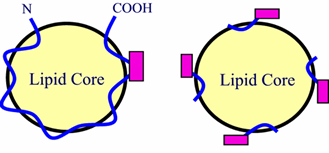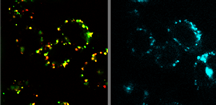APPLICATIONS OF TECHNOLOGY:
Natural LDL Berkeley Lab’s Synthetic nLDL

- Drug delivery to tumors with increased LDL-cholesterol requirements and LDL receptor activity, including: brain, colon, prostate, liver, lung, adrenal, hormone unresponsive breast, leukemia
ADVANTAGES:
- Targets the LDL receptor for selective drug delivery and entry into the lysosome
- Contains multiple copies of the peptide with the LDL receptor binding domain
- Easier to work with than native LDL
- Uses a bifunctional peptide that replaces apoB100, which is difficult to isolate
ABSTRACT:
Trudy Forte and Mina Nikanjam of Berkeley Lab and Children’s Hospital Oakland Research Institute (CHORI) have developed a synthetic nano-low density lipoprotein (nLDL) particle that targets the LDL receptor for selective drug delivery to tumors.Unlike native LDL, nLDL is easy to work with and its much smaller size (~10.5 nm) enables improved delivery to the tumor.
The Berkeley Lab/CHORI researchers have shown that glioblastoma multiforme (GBM) cells in culture have high numbers of LDL receptors. Since this receptor is nearly absent in neuronal and normal glial cells, it is an ideal target for the delivery of therapeutic agents such as cytotoxins to GBM tumors. GBM is a highly aggressive malignancy that accounts for approximately 85% of primary brain tumors in adults. Although Berkeley Lab/CHORI research has focused primarily on GBM, nLDL might also be used to target the many other types of cancer cells in which LDL receptors are upregulated.
The Berkeley Lab/CHORI nLDL particle is composed of a lipid emulsion with multiple copies of the synthetic peptide bound to its surface. The synthetic peptide is bifunctional, containing both a lipid binding domain and the nine-amino-acid LDL receptor binding domain. Research has demonstrated that nLDL has the ability to recognize the LDL receptor, competes with LDL for the receptor, enters cells intact, and is trafficked to the lysosome, as expected for LDL receptor-mediated uptake.


Confocal microscopy of SF-767 cells reveals colocalization of peptide and lipid in lysosomes. The representative images in A-D were obtained from live cells after 1 h incubation of cells with dual-labeled sLDL (1.5 µM peptide), where the peptide carried the FITC label and the lipid carried the DiI label; (A) FITC label of peptide, (B) DiI-label in lipids, (C) images in A and B merged to show co-localization of peptide and lipid, and (D) Lysotracker Blue image reveals co-localization of the peptide and lipid in lysosomes.
STATUS:
- Patent Pending. Available for licensing or collaborative research.
FOR MORE INFORMATION:
- Nikanjam, M., Blakely, E., Bjornstad, K., Shu, X., Budinger, T., Forte, T., “Synthetic Nano-Low Density Lipoprotien as Targeted Drug Delivery Vehicle for Glioblastoma Multiforme,” International Journal of Pharmaceutics 2006. in press. doi:10.1016/j.ijpharm.2006.07.046 .
- http://www.physorg.com/news77211026.html
REFERENCE NUMBER: IB-1931
SEE THESE OTHER BERKELEY LAB TECHNOLOGIES IN THIS FIELD: